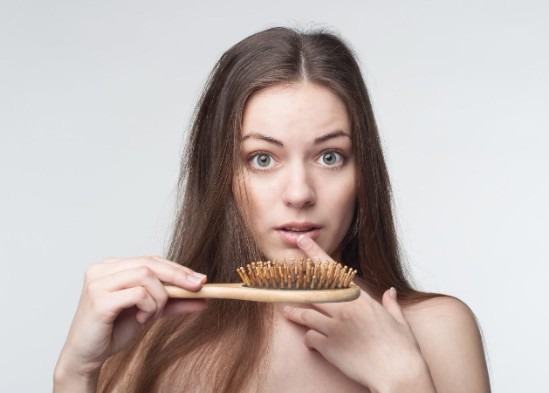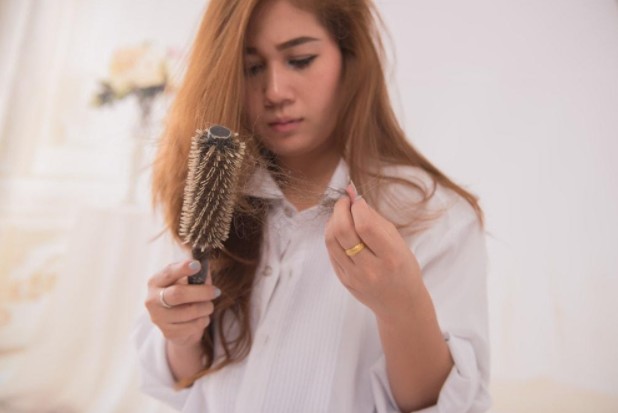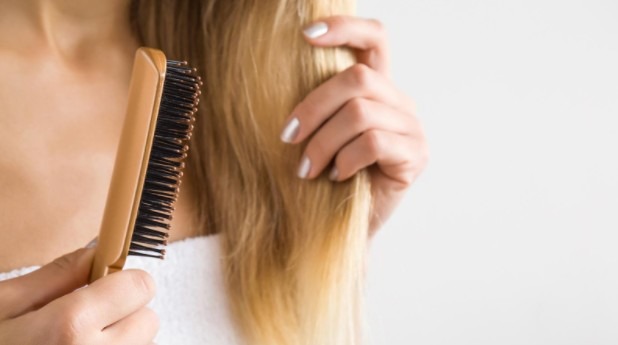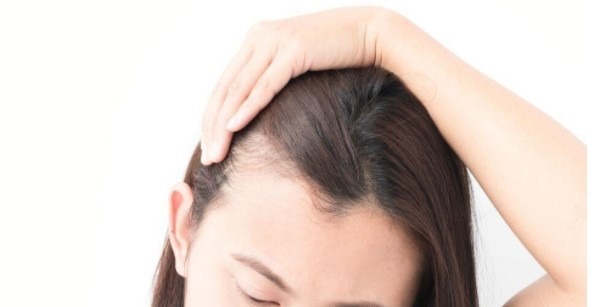Is your ponytail much thinner than it used to be? Is your shower drain clogged up after washing your hair? If so, these signs serve as indicators of an extremely common issue in females, known as alopecia.
Hair loss in women is often related to hormonal issues or stress, affecting at least one in three females. Freaking out is definitely not a solution for this problem, as it can be treated with natural remedies, medications, dietary changes, laser therapy, etc. In order to reduce the risk of excessive shedding, females can also take an array of preventative measures.
Here is everything you need to know about the causes, symptoms, and prevention of alopecia in women.
Causes
Hair loss can be genetic or reactive, depending on the cause that triggers the process of thinning and shedding. Many women are genetically predisposed to developing alopecia, which progresses as they age. In contrast, the majority of women experience hair loss at some point in life due to a trigger like a stressful situation, an illness, a deficiency of nutrients, etc.
A large number of females cope with alopecia due to hormonal imbalance. While estrogens are believed to assist the process of hair growth, androgens are responsible for doing the exact opposite. Consequently, women whose androgen levels are higher than normal are prone to shedding strands. Those genetically predisposed to alopecia are more affected by hormonal imbalance because of the sensitivity of follicles to androgens.
Stress is another common cause of alopecia, capable of making the hair fall out in a short time. It’s responsible for increasing the levels of androgen, which induces the process. Stress is also to blame for scalp problems and the disruption in eating habits.
Alopecia might result from a health problem related to the function of the thyroid gland. This endocrine gland is in charge of producing thyroxine (T4) and triiodothyronine (T3), ensuring the proper work of the body cells. When the thyroid gland is underactive, secreting an insufficient amount of these hormones, individuals experience hypothyroidism. Conversely, when this endocrine gland is overactive, it produces a greater amount of the hormone thyroxine, known as hyperthyroidism. Read more about the causes, symptoms, and risks of hyperthyroidism.
Thyroid imbalance is one of the leading causes of hair loss, affecting the production of proteins necessary for hair growth. Women struggling with the symptoms of thyroid imbalance are also likely to experience a change in the strength of follicles. Hypothyroidism might even lead to anemia, another potential cause of alopecia.
When females experience iron deficiency, the production of hair cell protein is minimized as well. If noticing symptoms of anemia, make sure to take a blood test and boost the presence of iron by following the recommendations of your GP.
Another type of deficiency that leads to alopecia is the lack of vitamin B12. An insufficient amount of this vitamin is believed to result in hair loss and reduce the number of red blood cells, whose job is to supply the tissues with oxygen. As a result, women suffering from B12 deficiency not only experience alopecia but also feel exhausted and feeble.
An unavoidable cause of hair loss is age, manifested in the period before and following menopause. The hair of women tends to thin and fall out prior to entering menopause, as well as in the period after it. See the following link, https://www.medicalnewstoday.com/articles/155651, to learn what to expect during menopause.
Ultimately, traction alopecia is common in women keen on experimenting with various hairstyles. Certain hairstyles like dreadlocks and braids are believed to put the follicles under a lot of strain, especially when worn repeatedly for longer periods. In order to avoid traction alopecia, females are advised to take a break between trying different hairstyles, as follicles need to rest.
Many women have hair loss as a result of extreme dieting because the body stops hair development in order to focus nutrients on the organs. Healthy hair requires a variety of minerals, including B vitamins like biotin, zinc, iron, and vitamin E.
Early signs
Women are supposed to be on the lookout for early signs of hair loss so as to treat the problem on time. For instance, noticing excess hair while brushing or after having a shower should be considered a warning. It’s expected for fifty to a hundred hairs to fall out during the day as part of the natural shedding process. Nevertheless, in the event of excessive falling out of strands, women are advised to immediately schedule a doctor consultation.
Another early sign of dealing with alopecia in females is a thinner ponytail. If you need to wrap the band a few more times around the ponytail, it’s a clear symptom of experiencing hair loss. Nevertheless, females might also experience thinning of their eyebrows and eyelashes.
When dealing with alopecia areata, known as an autoimmune disease, individuals lose hair not only on the scalp but the other parts of the body. This disease attacks the follicles and manifests with loss of eyelashes, eyebrows, and nose hairs.
In addition, the nails of individuals speak volumes about their overall health. Therefore, a change in nail beds might be a sign of alopecia, especially upon noticing white patches on your nails. Make sure to consult a doctor in order to determine the exact reason for hair loss.
Treatment
There is ultimately no one-size-fits-all solution, and the course of therapy you choose will be primarily influenced by the severity of your hair loss as well as the underlying cause. In order to solve the problem once and for all, it is crucial to seek professional assistance. Because hair loss and hair changes are complicated, you could need a few treatments in a customized mix.
Lifestyle Changes
Since your hair is a reflection of your overall health, it normally follows suit, at least in part, if you take care of your body. That covers everything from maintaining a healthy diet to exercising and reducing stress.
Minoxidil
Although it has been around for a while, this is the only FDA-approved medication that has been clinically proven to regrow hair. However, the exact mechanism by which it functions is unknown. The catch is that you must continue taking it frequently in order to notice and retain effects, even if it can be highly powerful.
PRP Injections
Your own blood is separated during this in-office process to remove platelet rich plasma (PRP), the portion of the blood that is rich in growth factors and signaling chemicals. It is believed that injecting it into the scalp will jumpstart the hair growth cycle. For those with more severe hair loss, it might be more efficient and produce faster results than other treatments, but keep in mind that it is a little intrusive, can be expensive, and needs to be performed frequently.
Other Topical Products
Many shampoos, conditioners, scalp sprays, and other products promise to produce amazing hair growth effects. They won’t actually cause hair to come back, but they can make your hair healthier overall, give it more resilience and strength, and make it appear fuller. In other words, they can have some positive effects when used in conjunction with another form of treatment. Consider using products that deliver essential nutrients and botanicals to the hair and scalp for thicker, healthier-looking hair.
Prevention
Women are capable of preventing alopecia by making certain changes in their lifestyle, diet, and daily habits. For instance, females are strongly advised against wearing hairstyles that overstrain the follicles and stretch the hair more than it can handle. Traction alopecia is manifested with female hair loss at the temples due to the constant pull on the scalp. Make sure you avoid tight braids, cornrows, and high ponytails if possible, as these hairstyles are believed to damage the scalp.
Another prevention tip most women refuse to follow is foregoing the use of hair-styling tools, such as curling irons, hairdryers, and hair straighteners. The prolonged use of these tools dehydrates the follicles and makes them susceptible to damage. The same goes for bleaching treatments like dyes, perms, and peroxide treatments. The damage these treatments cause to the follicles is irrevocable, which is why women should minimize their use.
Alopecia prevention is also possible by choosing the right type of shampoo, as the largest part of shampoos in the market contain harmful ingredients. Even though the role of shampoos is to eliminate the extra oil and dirt from the hair, some types of shampoo remove its natural oil and fatty acids, making it strong.
Moreover, women are recommended to be careful in the choice of a brush by choosing a model with natural fibers. By using a soft brush, you will promote the secretion of sebum, referring to the natural oil. It’s important to brush your hair in one direction by applying gentle movements.
When alopecia in females is caused by hormonal imbalance, iron deficiency, thyroid problems, or aging, doctors prescribe multiple treatments in the fight with this condition. For instance, anti-androgen medications like Aldactone are prescribed to women whose androgen hormones exceed the normal levels in the body. Oral contraceptives are also given to females dealing with hormonal imbalance. In contrast, iron supplements are prescribed to individuals whose alopecia is related to anemia.
Furthermore, females are encouraged to make dietary changes to prevent strands from falling out. Hence, women with androgenic alopecia should try to incorporate the Mediterranean diet into their lifestyle, which is abundant in herbs and vegetables. It’s vital for females to consume green veggies, parsley, and basil.
Given follicles are made of keratin, one of the most popular proteins; women should increase the consumption of proteins such as eggs, chicken, nuts, turkey, fish, peas, beans, etc. In order to boost hair growth and regulate sebum production, make sure you eat foods plentiful in vitamin A. Spinach, salmon, butter, cheddar, eggs, sweet potatoes, and sweet peppers are some of the foods containing this vitamin.
In addition, women suffering from a form of alopecia are recommended to include supplements into their diet. Vitamins A, vitamins B, C, and D induce hair growth, along with zinc, selenium, and iron. Ginseng supplements have also proven effective in the prevention of alopecia by improving scalp health.
Women should incorporate natural products in their daily routines, such as coconut oil and olive oil. The former is famous for its role in preventing the hair from breaking and protecting it against the harmful effect of UV rays. Conversely, the latter not only prevents breakage but reduces dryness as well. Olive oil can be applied as a treatment or consumed through the Mediterranean diet.
Other alternative methods applied in the prevention of alopecia are the use of essential oils, massage, and yoga. For example, massaging the scalp with a combination of rosemary, lavender, and cedarwood provides positive results. The same goes for essential oils like peppermint and lemongrass.
Yoga, on the other hand, is highly recommended to individuals coping with daily stress. Given stress triggers alopecia, females are advised to practice poses for relieving stress, such as the Camel Pose, Fish Pose, Shoulder Stand, etc.
Living with Hair Loss
Keep in mind that you are not the only one going through this. Before the age of 40, more than 30% of women will have hair loss, and as we age, we all experience hair loss to varying degrees. Be kind to yourself and wait patiently. After all, worrying about your thinning hair will make matters worse. Give yourself at least four to six months to see benefits from any type of treatment because hair grows slowly.
As you wait, you can employ a variety of quick styling techniques to give the appearance of bigger, thicker strands. The proper cut can also be beneficial, but what cut you need will primarily depend on your current length and texture. It is advised that you discuss your preferences with your stylist. Or have fun with fashionable accessories like headbands and scarves. Both are now in style and can be used to conceal thinning hair as well as poor hair days.
Final Thoughts
Instead of panicking, take an instant action in combating alopecia. Make the necessary lifestyle changes! Dealing with hair loss should be made at least a little bit easier by being honest and unashamed about what you’re going through, as well as by realizing that so many other women are in the same situation.




